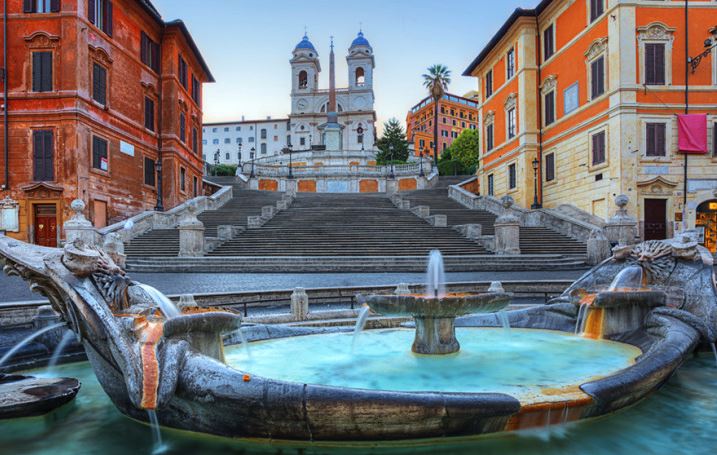Here are some Spanish steps facts, The Piazza di Spagna area of Rome is the most popular squares with its Spanish Steps overlooked by the Trinita Dei Monte Church. The square is situated in the city center and the main shopping street, Via Dei Condotti. Let’s have a look at the Spanish steps Rome facts, which helps you to discover some Spanish Steps History.
Interesting Facts about the Spanish Steps
1. The Spanish steps have a total of 135 steps.
2. The stairway was designed by two architects Francesco de Sanctis and Alessandro Specchi.
3. At the base of Spanish steps, you can find the Baroque fountain named Fontana della Barcaccia, “Fountain of the Ugly Boat,” which was built in 1627-29 by Pietro Bernini, who was the father of the famous son, Gian Lorenzo Bernini.
4. Bernini’s design, which shows a flooded boat at the center of a basin, which was inspired by the flooding of the Tiber River in 1598 when a small boat was alone here after the water subsided.
Read: Palatine Hill Facts
5. These Spanish Steps got its name from being in the vicinity of the original Spanish Embassy, which was situated at Piazza di Spagna.
6. At the end of the 15th century, only single small chapel existed on the hill where now stands the larger Trinita dei Monti Church. French King Louis XII commissioned the erection of a new church in 1495, replacing the small chapel. Construction started in 1502 and scribbled on for decades. Finally, It was consecrated in 1585 by Pope Sixtus V.
7. The obelus at the top of the steps is one of the 12 Egyptian obeli that are located in Rome.
8. It built from a gift of 20,000 Scudi, which was of Italian currency at the time, by French diplomat Étienne Gueffier in 1655.
9. The Spanish Steps were a link from the Bourbon Spanish Embassy and the Trinità dei Monti Church which was under the patronage of the Bourbon Kings of France.

Spanish Steps, Rome
10. Spanish steps fact tell you that at the right corner of the Spanish Steps, there is the house where English poet John Keats lived until his death in 1821. He died due to Tuberculosis at the age of 25. The house is now a museum which is dedicated to his memory, full of memorabilia of the English romantic generation.
11. These steps are one of the longest and widest staircases in Europe.
12. Eating and drinking are strictly forbidden in order to keep the staircase clean.
13. Work on the Spanish Steps started in 1723 and was opened in 1725.
14. The obelisk just in front of the church, Trinita dei Monti, was originally situated in the Gardens of Sallust. It was moved to its current location by the request of Pope Pius VI in 1789. It is a small copy of the obelisk to Pharaoh Rameses II.
15. The two bell towers on Trinita dei Monti one indicated the French hour, while the other followed the Italian hour, which was replaced by a sundial after 1847 when the Italian system was left out.
Don’t Miss
So far we provide you the brief information about the Spanish steps facts, which will help readers to discover more these Spanish steps Rome facts. Hope you loved reading this article and gathered some related information. If you are interested to explore more about the roman facts then kindly go through our other blogs as well. If you loved it then please like the post and share your views in the comment section.
The post Spanish Steps History | Interesting Facts About Spanish Steps appeared first on World Tour & Travel Guide, Get Travel Tips, Information, Discover Travel Destination | Adequate Travel.